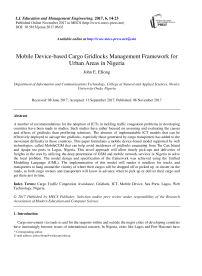Mobile Device-based Cargo Gridlocks Management Framework for Urban Areas in Nigeria
Автор: John E. Efiong
Журнал: International Journal of Education and Management Engineering(IJEME) @ijeme
Статья в выпуске: 6 vol.7, 2017 года.
Бесплатный доступ
A number of recommendations for the adoption of ICTs in tackling traffic congestion problems in developing countries have been made in studies. Such studies have rather focused on assessing and evaluating the causes and effects of gridlocks than proffering solutions. The absence of implementable ICT models that can be effectively deployed to salvage the gridlocks, especially those generated by cargo transporters has added to the movement difficulty in these countries. This paper formulates a mobile device-based model supported by web technologies, called MobileCGM that can help avoid incidences of gridlocks emanating from Tin Can Island and Apapa sea ports in Lagos, Nigeria. This novel approach will allow timely pick-ups and deliveries of freights in the area by utilizing the deep penetration of GSM and mobile network services in Nigeria to solve the local problem. The model design and specification of the framework was achieved using the Unified Modelling Language (UML). The implementation of this model will render it needless for trucks and transporters to hang around the vicinity of where their cargos will be dropped off or picked up or cluster on the roads, as both cargo owners and transporters will know in advance when to pick up or deliver their cargo and get there just in time.
Cargo Traffic Congestion Avoidance, Gridlock, ICT, Mobile Device, Sea Ports, Lagos, Web Technology, Nigeria
Короткий адрес: https://sciup.org/15014080
IDR: 15014080
Список литературы Mobile Device-based Cargo Gridlocks Management Framework for Urban Areas in Nigeria
- Aderamo, A. J. “Urban Transportation Problems and Challenges in Nigeria: A Planner’s View”. Prime Research on Education (PRE), 2012, 2(3): 198-203, Available at www.primejournal.org/PRE.
- Agbonkhese, O; Yisa, G. L; Agbonkhese, E.G; Akanbi, D.O.; Aka, E.O and Mondigha, E. B. “Road Traffic Accidents in Nigeria: Causes and Preventive Measures”. Civil and Environmental Research, 2013, 3(13):90-100.
- Aworemi, J. R., Abdul-Azeez, A. J. Oyedokun and J. O. Adewoye. “A Study of the Causes, Effects and Ameliorative Measures of Road Traffic Congestion in Lagos Metropolis”. European Journal of Social Sciences, 2009, 11(1).
- Eniola, O. J., Ikpechukwu, N., Akinsulire, E. S. and Enosko, O. “Traffic Management Problems in Lagos: A Focus on Alaba International Market Road, Ojo, Lagos State Nigeria”. Journal of Economics and Sustainable Development, 4 2013, (4):144-154.
- Fadare, S. O. and Ayantoyinbo, B. B. “A Study of the Effects of Road Traffic Congestion on Freight Movement in Lagos Metropolis”, European Journal of Social Sciences, 2010, 16(3):429-437.
- GSMA Digital Inclusion. Digital Inclusion and the Role of Mobile in Nigeria. Retrieved from www.gsma.com/digitalinclusion, 2015. Accessed 24/04/2017.
- Idachaba, F. E. and Ibhaze, A. E. “GSM/GPS Assisted Road and Traffic Congestion Detection System”. International Journal of Applied Engineering Research, 2016, 11(24): 11610-11613. Research India Publications. Retrieved from http://www.ripublication.com. Accessed 24/04/2017
- Nigerian Ports Authority (2017). Nigerian Ports Authority Statistics. Retrieved from http://www.nigerianports.org/defaultLagosPort.aspx?Pid=274. Accessed 24/04/2017.
- Nwagwu, I. and Oni, T. (2015). “Lagos and Its Potentials for Economic Growth. Heinrich-Böll-Stiftung”. Retrieved from https://ng.boell.org/2015/07/02/lagos-and-its-potentials-economic-growth. Accessed 24/04/2017.
- Olagunju, K. “Evaluating Traffic Congestion in Developing Countries – A Case Study of Nigeria”. A Paper Presented at the 2015 Chartered Institute of Logistics and Transport (CILT), Africa Forum, Mount Meru Hotel Arusha, Tanzania, 4th March, 2015.
- Olayiwola, K. O., A. M. Olaseni and O. Fashina. “Traffic Congestion Problems in Central Business District (CBD), Ikeja, Lagos Metropolis, Nigeria”. Research on Humanities and Social Sciences, 4(1):23-32.
- Oni, O. A. G. “Tackling Road Traffic Congestion in a Developing Country – A Contemporary Approach”. Journal of Applied Sciences Research, 2010, 6(5): 529-542.
- Statista. (2014). Number of smartphone users in Nigeria from 2014 to 2019 (in millions). Retrieved from https://www.statista.com/statistics/467187/forecast-of-smartphone-users-in-nigeria/. Accessed 24/04/2017.
- Ukpata, J. O. and A. A. Etika. “Traffic Congestion in Major Cities of Nigeria”. International Journal of Engineering and Technology, (IJET), 2012, 2 (8): 1433-1438.
- Efiong, J. E. and F. O. Aranuwa (2017). “Mobile Devices’ Features and Usability: The Nigerian Utilization Experience”. International Journal of Computer Trends and Technology (IJCTT), 2017, 48(4), 200-207.
- Goyal K. and D. Kaur, ”A Novel Vehicle Classification Model for Urban Traffic Surveillance Using the Deep Neural Network Model”, International Journal of Education and Management Engineering(IJEME), 2016, 6(1):18-31,.DOI: 10.5815/ijeme.2016.01.03
- Chen, X., Shiming, X., Liu,C. L., and Pan, C.H. “Vehicle Detection in Satellite Images by Hybrid Deep Convolutional Neural Networks”. Geoscience and Remote Sensing Letters, IEEE 11, 2014, 11(10): 1797-1801.
- Sivaraman, S., and M. M. Trivedi. “Looking at Vehicles on the Road: A Survey of Vision-based Vehicle Detection, Tracking, and Behaviour Analysis”. Intelligent Transportation Systems, IEEE Transactions, 2013, 14(4): 1773-1795.
- Mithun, N. C., Rashid, N.U. and Rahman, S.M.M. “Detection and classification of vehicles from video using multiple time-spatial images", IEEE Transactions on Intelligent Transportation Systems, 2012, 13(1):1215-1225.
- Mei, X. and Ling, H. “Robust Visual Tracking and Vehicle Classification via Sparse Representation”, IEEE Transactions on Pattern Analysis and Machine Intelligence, 2011, 33(1), 2259-2272.
- S. Peng, C.A. Harlow, “A System for Vehicle Classification from Range Imagery”, Proceedings of the IEEE 28th Southeastern Symposium on System Theory, 1996, 327-331.
- Runyoro, A. K. and Ko, J. “Mobile Phone Based RIMS for Traffic Control a Case Study of Tanzania”, International Journal of Information Technology and Computer Science (IJITCS), 2015, 7(5): 55-60. DOI: 10.5815/ijitcs.2015.05.08
- Duncombe, R., Researching Impact of Mobile Phones for Development: Concepts, Methods and Lessons for Practice. Information Technology for Development, 2011, 17(4): 268-288.
- Duncombe, R. Understanding Mobile Phone Impact on Livelihoods in Developing Countries: A new Research Framework. Manchester Centre for Development Informatics, Working Paper 48, 2012; Available at the website: http://www.sed.manchester.ac.uk/idpm/research/publications/wp/di/di_wp48.htm. (Accessed on 12th September, 2017).
- Ahmad, M., Raza, W., Omer, Z. and Asif, M. “A Participatory System to Sense the Road Conditions”, International Journal of Engineering and Manufacturing(IJEM), Vol.7, No.3, pp.31-40, 2017.DOI: 10.5815/ijem.2017.03.04.


